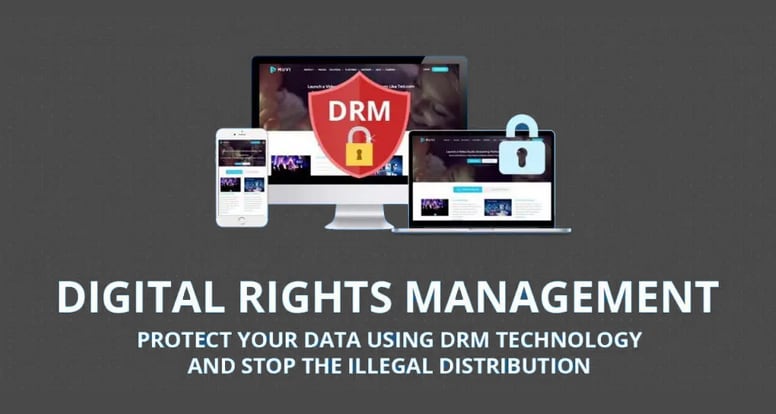
Digital rights management (DRM) uses technology to manage and limit access to copy-protected content. Another DRM definition is transferring control of digital content from its owner to a computer program. DRM strives to safeguard the rights of the copyright holder and prohibit the unlawful distribution and modification of content.
As digital content grows through peer-to-peer file exchanges, torrent sites, and online piracy, DRM becomes more important. It helps entertainment and media enterprises minimize the cybersecurity risks faced by all organizations, such as securing consumer data, assuring and showing compliance, boosting operational efficiency, and reducing downtime.
DRM allows writers, musicians, filmmakers, and other content providers to specify and restrict users’ access to their content. It also enables them to secure their copyrighted content, preserve their creative and financial investment in their work, and prevent their media from being unlawfully copied or disseminated. For instance, they may block users from gaining access to certain assets, avoiding any legal concerns arising from illicit use. It is essential for the protection of intellectual property and copyright.
What is Digital Rights Management (DRM)?
Digital rights management is a collection of hardware and software solutions developed to regulate how content/information assets are used, edited, and shared online and offline. DRM is sometimes known as technical protection measures (TPM) since it focuses on safeguarding the copyright of technology-enabled content.
As our usage of digital information increases, so make copyright management difficulties. In the early days of computers, users were prohibited from saving a copy of the material on a local device due to copy-protected floppy discs. With the proliferation of OTT and cloud-based content sharing, the concept of digital rights management has expanded. Almost all information you consume today, from iTunes to Netflix, is protected by DRM technology. DRM encompasses business content such as intellectual property, secret documents, etc.
The worldwide DRM market was valued at $2.94 billion in 2019 and is anticipated to double by 2025 at a CAGR of 12.65%. Its robust growth rate implies a need for digital rights management services and solutions that safeguard corporate and consumer-facing content from unethical access.
How Digital Rights Management Works
Typically, digital rights management includes codes that restrict copying or limit the amount of time or number of devices that may access a particular product.
Publishers, writers, and other content producers use a program that encrypts media, data, e-books, content, software, and other copyrighted content. Those who possess the decryption keys are the only ones who can access the content. Additionally, they may use technologies to control or restrict what users can do with their assets.
There are several methods for securing your content, software, or product. DRM allows you to:
- Restrict or prohibit the editing and storing of your content.
- Limit or prohibit people from sending or sharing your goods or content.
- Restrict or prohibit the publishing of your content. For example, the document or artwork may only be printed many times for specific individuals.
- Do not let people take screenshots or screen captures of your content.
- Set an expiration date for your document or medium, after which the user will no longer have access to it. It might also be accomplished by restricting a user’s use. For example, a document may be canceled once the user has listened to it ten times or accessed and printed the PDF twenty times.
- Only permit access to specific IP addresses, locations, or devices. It implies that if your content is restricted to US citizens exclusively, it will be inaccessible to individuals in other countries.
- The purpose of watermarking artworks and documents is to confirm ownership and identification.
Digital rights management also enables publishers and writers to track the individuals and times when certain media, content, or software was used. For instance, you can know who accessed a specific e-book and when it was downloaded or printed.
Digital Rights Management Use Cases
DRM is used to protect a large variety of digital content, including books, music, and videos, as well as database subscriptions, software applications, and critical corporate data. Using DRM to safeguard this media allows content producers and copyright holders to restrict individuals from changing their work or using it for reasons other than intended.
Here are a few real-world cases of DRM:
1. Apple iTunes
DRM is used by Apple’s iTunes store to restrict the number of devices users may use to listen to music. Users’ purchase and use of music are included in the audio files they download from iTunes. It stops unauthorized devices from accessing the data. Apple also uses FairPlay technology to safeguard the content in its iBooks store, ensuring that books can only be viewed on iOS devices.
2. Digital Music
Spotify uses blockchain technology to allow bitcoin payments to musicians. The music streaming service purchased the startup Mediachain to assist it in identifying tracks that were played and the correct artist to pay using DRM.
3. Microsoft Software
Before installing Microsoft software, such as Windows or Office products, users must accept the company’s user license and input a key. Microsoft also offers PlayReady DRM technology, which protects content delivery over a network and prohibits unlawful usage of its products.
4. Sensitive Documents
DRM technology is used by many organizations to protect business-critical documents or sensitive information, such as private employee data, business plans, and contracts. DRM allows enterprises to trace who has accessed their files, regulate access to them, and govern how others may use them. It also stops files from being changed, copied, saved, or printed.
5. Regulation Compliance
DRM is essential for helping organizations in complying with data protection rules. It helps healthcare businesses, for example, to fulfill the standards of the Health Insurance Portability and Accountability Act (HIPAA), and it supports all organizations in meeting the requirements of the California Consumer Privacy Act (CCPA) and the EU’s General Data Protection Regulation (GDPR).
Advantages of Digital Rights Management
DRM offers numerous significant advantages in protecting copyright holders and content producers against theft.
1. Copyright Education
Many individuals overlook the copyright specifics of the information they possess. DRM enables organizations to adequately express to consumers what they can and cannot do with their digital content, educating people on how copyright and intellectual property function.
2. Securing Ownership
Digital rights management (DRM) is critical for assisting authors and writers in protecting their work. They may employ technology to protect their content and prevent others from modifying or rebranding it as their own. It is especially beneficial for scientists who wish to safeguard their discoveries and innovations.
3. Income Protection
Creating, shooting, and editing documentaries, movies, and other media costs money, and artists intend to sell their material for a profit. They may lose money if such content is leaked or disseminated without permission. DRM allows content publishers to restrict access to their videos to paying customers exclusively.
4. Ensuring appropriate content access
DRM restricts content to specified audiences and limits content to targeted audiences, ensuring proper content access. Content meant for persons above 18 will, for example, be limited to adults who can prove their age.
5. File Privacy
DRM assists companies in securing sensitive data and keeping them private. Unauthorized users are prevented from accessing or viewing confidential or sensitive information due to this.
Best Digital Rights Management Practices in 2022
Surprisingly, complex technology or specific Digital Rights Management services are optional. Instead, simple precautions such as password encrypting a PDF before sharing it or putting a watermark on an Instagram post might help with fair use, depending on your use case. If you want to begin using DRM in 2022 – at whatever level – keep the following ten recommended practices in mind:
1. Before applying DRM, create a content selection framework.
DRM is optional for some content. However, in certain circumstances, DRM protections might prohibit your content from obtaining the desired level of reach and engagement. That is why, before implementing DRM, a content selection structure must be in place. For example, a small production company may wish to use DRM for the latest movie rather than for its trailer.
The indiscriminate use of DRM systems will restrict sharing. Instead, consider creating a diversity and inclusion presentation deck. You want the deck to reach as many individuals as possible within and beyond your organization. You desire social media conversation, engagement, and reach; a sophisticated DRM system such as passwords or device-based verification will only obstruct this.
When picking content for DRM, consider the following:
- Is it monetizable for me/will it lead to monetization?
- Is it monetizable/will a rival benefit from it?
- Unregulated distribution may violate internal, industrial, or regional regulations.
2. Make the most of your investments using free digital rights management technologies.
It’s a prevalent fallacy that only the most costly or premium DRM systems can protect your content from unauthorized usage. Instead, DRM is as much about attitude as technology; for example, requiring staff to password-protect every document might be as successful in controlling distribution as using free DRM solutions or current technologies like MS Word.
InstallAware and Drumlin Publishing are two free solutions you may use for Digital Rights Management. InstallAware is designed for application DRM, allowing you to secure your software without modifying the source code. Drumlin is a PDF security program that will enable you to define permissions and apply watermarks to PDF files.
3. Conduct company-wide surveys to get user acceptance.
Enterprise DRM is concerned with safeguarding data transfers rather than limiting access. It makes obtaining buy-in and active support from your target user base – your workers – critical. Ineffective DRM will eventually lead to content-sharing bottlenecks and may even demand a costly DRM update.
A solid rule of thumb is to assemble a focus group with representatives from your enterprise’s core content audiences. Trial several DRM scenarios with this focus group, completing extensive questionnaires to assess their quality of experience and potential productivity implications. Once you have a credible DRM implementation strategy, do a quick company-wide poll to gauge employee sentiment.
If you cannot acquire buy-in from a substantial user base, you must reconsider your DRM plans as soon as possible.
4. Complement other data management infrastructure.
DRM, like other technologies, works best when combined with complementary solutions like data loss prevention (DLP), digital asset management (DAM), and content management systems (CMS).
A DLP program will limit data sharing in specific circumstances to avoid data loss or leakage. You may combine this with DRM to ensure procedures are followed when exchanging data inside the scope of your DLP.
One of the best practices is to have a designated “data owner” in place who is responsible for data loss, rights management, and the general use and distribution plan. This owner might be a single senior management stakeholder, a team dedicated to ensuring safe data or content usage, or even a third-party expert with years of experience in data management best practices. However, integrating DRM with the other components of your technology stack is the first step toward benefiting from this unified view and administration.
5. Be aware of the drawbacks of digital rights management.
DRM has its detractors. One may claim that DRM violates the fundamental ownership rights of someone who has legitimately acquired content. For example, imagine you bought an eBook and want to read it on any device you choose. On a less philosophical level, complex DRM operations might impede the user experience, discourage use, and even drive customers to migrate to a competitor platform.
Companies may solve these drawbacks by conducting surveys (see point 3) and matching the DRM technical architecture with UX requirements.
6. Distribute the compliance load across users and IT.
By putting the whole weight of DRM compliance on users, company risk is multiplied. Even if the DRM solutions we discussed limit how workers use and distribute content, they are also intended to improve awareness. Employees may discover workarounds to the limits and lessen their effect if they need to grasp what Digital Rights Management is and why it is vital (e.g., sharing document passwords with a family member).
That is why sharing the compliance responsibility between users, and your IT department is beneficial. It may include DRM in its broader IT policy structure, assuming responsibility for enforcing it throughout the user base. Employees, in turn, are held responsible to both IT and the corporation as a whole.
7. Reduce the use of shadow IT and unmapped distribution routes.
Shadow IT has long been a nightmare for data owners, making it impossible to oversee data transfer and consumption across these covert channels. Limiting shadow, IT may assist in minimizing your DRM load.
Shadow IT is a significant concern for practically every large-to-mid-sized organization, with so many of us working from home. Employees routinely use personal devices for work, installing SaaS programs that may violate the enterprise’s IT policies. Sharing files, papers, and data across these channels is classified as shadow IT, which is difficult to monitor. Consequently, corporations must spend extensively on DRM, expanding coverage beyond the content assets outlined under point 1.
Shadow removal IT will reduce your DRM burdens, allowing you to focus your investments better.
8. Allow for scalability and flexibility as the landscape changes.
Your approach to Digital Rights Management must change in parallel with the advancement of content formats, distribution methods, and DRM technology. Furthermore, your DRM should be able to adapt to corporate development and new business models. For example, a research business may desire to transition from static content assets to dynamic/topical content reports. The latter will need a different DRM solution, such as time-bound decryption keys, then the former.
According to this best practice, organizations should investigate upcoming DRM solutions such as point-to-point protection and blockchain to remain ahead of unethical actors. Point-to-point security allows for the seamless authentication of high-definition video content without needing an internet connection, preserving the user experience. Because of its transparency and immutability, blockchain is another promising DRM option.
Sony, for example, is already working on a blockchain system for IP Digital Rights Management.
Learn from your mistakes when it comes to DRM. Companies must keep up with changing customer attitudes about digital content and staff expectations in various working arrangements. DRM should not obstruct engaging experiences or productivity. Fortunately, today’s billion-dollar industry provides you with the necessary Digital Rights Management services and technologies to do this at a low cost.
Best Digital Rights Management (DRM) Software
Digital rights management (DRM) software offers users many features designed to protect their content and guarantee that it may only be accessed within their chosen boundaries. Businesses often exchange files internally and internationally, while others frequently share branded assets or host media files. DRM systems safeguard the content shared or stored by enterprises, ensuring that it is only used as intended. DRM software may include features such as watermarking and expiry dates for shared documents and subscription and licensing management for media assets. In addition, DRM systems often use encryption software for safe file transfers.
Many digital asset management software feature full-fledged DRM to enable the secure distribution of branded assets. In addition, some virtual data room software providers also provide DRM software for secure file sharing outside of a VDR.
To be included in the Digital Rights Management (DRM) category, a product must meet the following requirements:
1. Watermarks
Assets may be imprinted with graphical files that allow producers or copyright holders to trace illicit use. The watermark remains attached to a file even when the digital material is duplicated, altered, or converted to a different format.
2. Metadata
Digital assets include metadata that allows the acquisition and monitoring of their copyright and license information. It is essential to monitor the license information of stock music files, images, and videos to prevent their unlawful use.
3. Embed Codes
Content owners may also manage how and where their material is disseminated online using embedded codes. It is helpful if the license of an image changes or expires because it enables the right to be changed or updated wherever the related embed code has been posted online. This procedure is often called “create once, publish everywhere” (COPE), which is fundamental to a successful DRM approach.
4. License Agreements
Organizations may safeguard their information and software by requiring users to read and accept their end-user licensing agreement (EULA). EULA is accepted the first time a user uses a website, exchanges files, or downloads material, enabling enterprises to safeguard their assets against unlawful use.
Some of the best DRM software are;
- Pex
- DRM
- Bynder
- Digify
- Sesimi
- DRMtoday
- FotoWare
- Widevine
- PallyCon
- MerlinOne
- Copyscape
- Flowhaven
- CapLinked
- EditionGuard
- Vera Security
- Primetime DRM
- Vitrium Systems
- Widen Collective
- StarForce Content
- FileOpen RightsManager
Media and Entertainment Cybersecurity Challenges
DRM is essential for protecting digital content, but media and entertainment organizations must also have adequate security systems and procedures to safeguard their content. However, they confront common obstacles, such as:
1. Intellectual property protection
Protecting content such as music files, movies, and videos, along with contract discussions, screenplays, and deleted sequences, is essential for media and entertainment organizations. The Sony Pictures breach, which exposed employee data and unreleased films, plans, and screenplays for future projects, brought attention to this problem. In addition, such content distribution may significantly affect a company’s revenue and reputation, making DRM essential for securing its content.
2. Network visibility
Many entertainment and media organizations employ cutting-edge technology to enhance the client experience. However, the proliferation of cloud, mobile, and Internet of Things (IoT) devices not only makes maintaining the corporate network more challenging but also increases the attack surface of enterprises. Furthermore, it is worsened when additional security solutions are deployed to safeguard their infrastructure, resulting in security silos that reduce visibility, increase inefficiency, and raise the risk.
3. Protecting investments
Before entertainment and media products may generate a profit, a substantial initial investment is required. Therefore, organizations must prioritize security expenditures to safeguard their assets and reduce risk.
4. Managing customer experience
As the quick expansion of streaming services, online gaming, and virtual reality demonstrates, digital innovation is mainly focused on customer experience. Even a small disruption in the connection may have a detrimental impact on these services, which rely on secure and dependable cloud-based solutions and mobile networks. Businesses must fulfill client demands to safeguard their brand and avert financial loss.
5. Protecting client data
It is particularly important to big media and entertainment corporations, subject to increasingly severe data and privacy legislation. These companies must maintain the security of millions of individuals’ personal and financial information. Additionally, they must ensure compliance with the expanding regulatory framework without redeploying personnel devoted to achieving strategic projects.
Final Words DRM – Digital Rights Management
Digital rights management (DRM) may be enabled by software that encrypts data or digital media, including books, music, movies, software, videos, and other copy-protected content. It guarantees that only users with the correct key may access the content and restricts the activities performed with digital media.
DRM is the use of technology to regulate access to protected content. It also allows copyright holders and content producers to control what users can do with their content, such as the number of devices they may use to view media and whether it can be shared. As a result, DRM is becoming more vital for securing content against the development of internet piracy and illicit file-sharing services.
The major drawback of DRM is that it may be expensive for content creators to encode their work. They may also lose sales to those who do not want to buy DRM-protected products.



